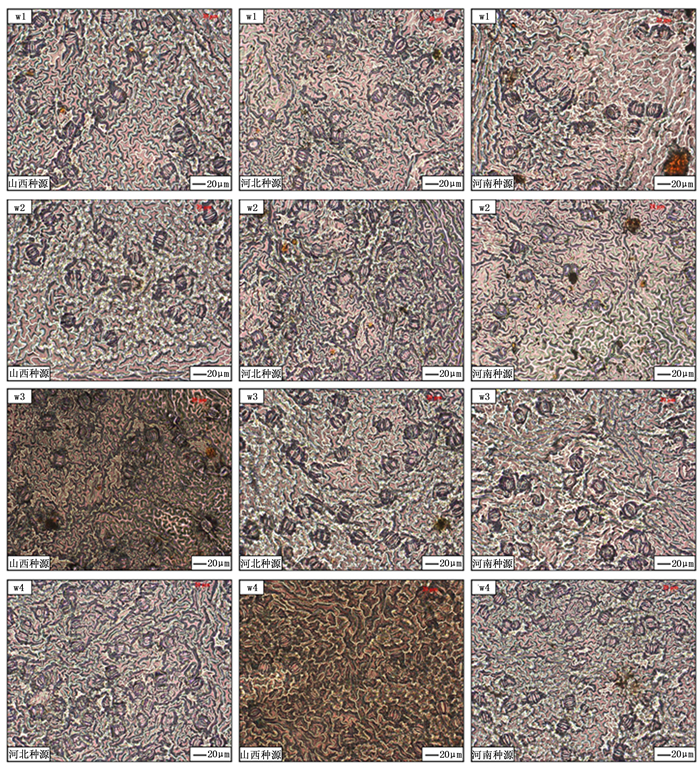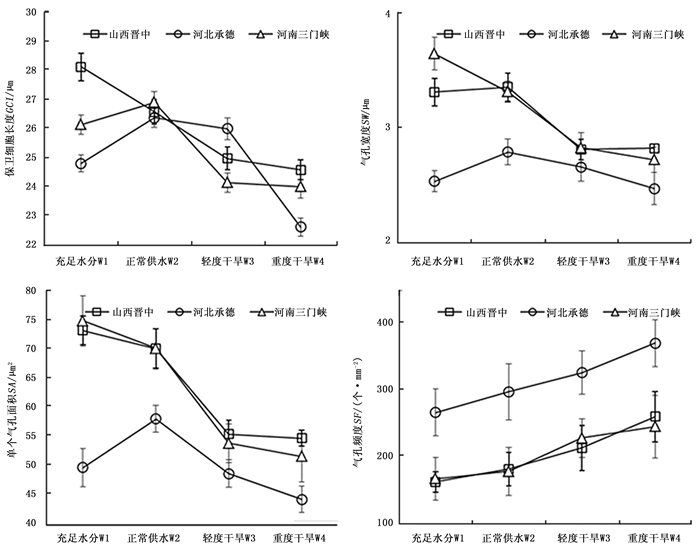-
文冠果(Xanthoceras sorbifolium Bunge)为无患子科(Sapindaceae)文冠果属(Xanthoceras Bunge)植物,是我国特有的油料树种,喜光、耐瘠薄、耐干旱、耐寒冷,有较高的药用价值和经济价值[1]。种仁含油量较高,可达60%以上,是生产天然功能性食品、药品、化妆品的优质原料,也是值得推广的高级工业产品树种[2-3];种仁蛋白氨基酸种类齐全,可以用作高端饮料、乳化剂和食品添加剂的原料,同时,种皮和果壳也是优质活性炭的优质原料。文冠果主要分布于我国干旱的“三北”地区,制约其可持续发展的最主要因素就是干旱缺水。叶片气孔作为植物表皮的特殊结构[4],其特征的变化与干旱胁迫的关系成为近年来生态学研究的热点问题之一[5-6]。截至目前,关于文冠果叶片气孔分布特征的研究报道较少,仅限于同一材料单一水分条件下[7-10]。本研究以我国华北地区的河南三门峡、河北承德及山西晋中3个种源文冠果为研究对象,开展水分梯度控制试验,研究其叶片气孔分布特征对水分胁迫的响应,为华北地区抗旱文冠果种源的选择提供理论依据。
HTML
-
2015年8 —9月,分别于山西省晋中市、河北省承德市和河南省三门峡市3个种源地采集文冠果完全成熟种子。首先,在上述3个种源地分别选择30~50株成熟母树,在不同部位采集种子混合,每个种源收集种子1 kg左右。然后取回实验室,常温储存,11月份沙藏。
2016年4月初,采用中国林业科学研究院林业研究所引进的美国根生产法(RPM)容器苗技术将3个种源文冠果的沙藏种子播种于院科研温室的塑料盆内[11-12]。塑料盆高20 cm,直径20 cm,盆中基质按普通泥土(壤土)、草炭土和蛭石为8:1:1的比例组成。土壤密度为1.32 g·cm-3,田间持水量为36.22%;每个种源播种40盆,3个种源共120盆;出苗20 d后进行定苗,每盆分别留3株生长状况较为一致的健壮幼苗。
-
2016年5月初,分别将3个种源文冠果幼苗随机分成4个水分梯度进行控制试验。4个梯度分别按照土壤含水量为田间最大持水量的100%(充足水分,W1)、75%(正常供水,W2)、50%(轻度干旱,W3)和20%(重度干旱,W4)设置[13],每个种源每个梯度处理均为10盆。首先将供试120盆苗木浇透水,然后进行自然干旱处理。每天使用TDR仪测定土壤含水量数据,对土壤含水量不足处理的苗木进行补水,直至控制在试验设计的水平。5月14日各处理均达到试验设定的水分梯度,并正式开始水分胁迫试验。每日测定土壤含水量,然后通过补充散失水分将土壤含水量控制在设定水平。
-
控水试验后第75天,河南三门峡及山西晋中种源的重度水分胁迫处理W4的叶片发黄凋落,其中河南三门峡种源最为严重(图 1),天气晴朗的上午,均匀采集不同种源不同处理文冠果苗木中部成熟叶片,每株苗木东南西北方向各1片,共4片,采集叶片中部的3个完整小叶片(河南三门峡种源苗木重度水分胁迫处理W4下,小叶片大都凋落,不足3个时采集全部小叶片),采用指甲油印迹法进行叶片气孔分布特征值的测定[14],即将指甲油印记切片放于光学显微镜下观察并拍照,每个小叶片均匀选取10个视野进行测量,包括气孔频度(SF)、保卫细胞的长度(GCL)、气孔宽度(SW)和单个气孔面积(SA),其中气孔频度SF=气孔个数/单位面积(mm2),单个气孔面积SA=π×GCL×SW/4;气孔总面积占叶片面积比例(SP),即SP=SF×SA×100%;总气孔开口面积指数(SPI),即SPI=SF×GCL2[14-17]。
-
对不同种源及不同水分处理下的文冠果叶片气孔分布特征等指标测定数据的方差分析及多重比较(LSD法)均运用SPSS18.0(SPSS Inc.,USA)软件进行统计分析。
1.1. 试验材料
1.2. 试验处理
1.3. 样品采集及测定
1.4. 数据处理
-
分别对3个种源不同胁迫处理下的叶片正反面进行气孔分布观测(图 2),发现其气孔均分布在叶片下表皮,而上表皮均无气孔分布,这与木本植物气孔只分布在下表皮相一致[18]。因此,本研究提到的气孔分布特征均指叶片下表皮气孔分布特征。
-
从图 2和图 3中可以明显看出,山西晋中、河北承德和河南三门峡3个种源均在W3轻度和W4重度干旱胁迫下,叶片气孔器的大小,包括保卫细胞的长度(GCL)、气孔器宽度(SW)和单个气孔面积(SA)均明显变小(P < 0.001),而气孔频度(SF)明显增大(P < 0.001),表明不同种源文冠果气孔大小及频度对干旱胁迫有着明显响应,随着干旱胁迫程度加剧,叶片可通过减小气孔面积和增大气孔频度趋于旱生结构,进行气孔调节,来应对干旱胁迫,其中河北承德种源文冠果尤为明显。
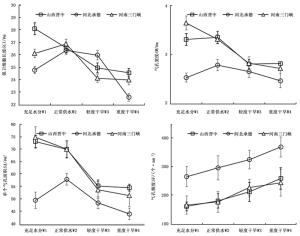
Figure 3. Change in stomatal size and frequentness of yellow horn leaf from different provenance under different water stress
河北承德种源文冠果叶片保卫细胞的长度(GCL),在充足水分W1条件下,显著小于山西晋中和河南三门峡种源,正常供水W2条件下,3个种源保卫细胞长度差异并不显著,而随着干旱胁迫程度加剧,保卫细胞的长度均在减小,其中河北承德种源在重度干旱胁迫W4下,保卫细胞长度下降到最小,为22.58±0.32 μm;河北承德种源文冠果叶片的气孔宽度(SW)及单个气孔面积(SA)在不同水分胁迫处理下均显著小于山西晋中和河南三门峡种源(P < 0.001),而山西晋中和河南三门峡两种源间差异并不显著;河北承德种源在各处理条件下的气孔频度,均显著大于山西晋中和河南三门峡种源。总之,从文冠果叶片气孔的大小及频度可以看出,河北承德种源比其它两种源具有更为明显的气孔面积小、频度高以及调节能力强等特征。
-
从图 2和图 4中可以看出,3个种源不同处理下气孔总面积占叶片面积的比例(SP)为1.16%~1.76%,除充足水分胁迫W1下气孔总面积占叶片面积比例较小,河北承德种源其他处理均显著大于山西晋中和河南三门峡种源,其中山西晋中和河南三门峡种源之间差异不显著;河北承德种源的气孔开口面积指数(SPI)在不同水分处理条件下均明显大于山西晋中和河南三门峡种源(P < 0.001),且随着干旱胁迫的加重,先呈缓慢增加而后显著下降的趋势(P < 0.001),而山西晋中和河南三门峡种源在不同水分处理条件下,气孔开口面积指数(SPI)没有显著的变化。
2.1. 文冠果叶片气孔大小及频度对不同水分胁迫的响应
2.2. 不同种源文冠果叶片气孔总面积比例及开口面积指数对不同水分胁迫的响应
-
叶片气孔是植物叶片进行光合作用以及蒸腾作用的重要结构,它对周围环境的变化会表现出一定程度的响应能力[19-21]。本研究发现,3个种源在不同干旱胁迫处理后,其叶片均有不同程度趋于旱生结构的趋势,气孔均变得小而多,可较好地进行气孔调节,减少水分散失,能在消耗较少水分条件下进行光合作用,从而提高水分利用效率,这与大多学者的研究结论较为相似[21-23]。但是不同种源文冠果的叶片气孔分布特征对干旱胁迫响应程度明显不同,其中河北承德种源文冠果对干旱胁迫的响应程度明显要高,气孔总面积占叶片面积的比例和气孔开口面积指数在干旱胁迫下均呈现出先增加,然后随着干旱胁迫的程度加重而降低的趋势,而山西晋中和河南三门峡种源在干旱胁迫下这两个指标无显著变化。
有研究表明,抗旱性较强的植物气孔小且密度大,调节气孔开张能力强[21-24]。在旱作环境下,同一植物种不同品种的气孔的大小和频度均有差异,抗旱性强的品种气孔小,有利于植物减少蒸腾,进而提高其水分利用效率;气孔频度大,有利于气体交换,增加进入体内CO2浓度,从而增强其抗旱性[24-27]。本研究结果表明,不同水分胁迫处理后,河北承德种源文冠果的叶片气孔器大小显著小于山西晋中和河南三门峡种源,而气孔频度显著大于这两种源地,说明河北承德种源是3个种源中抗旱性最强的种源,这也与重度干旱胁迫75天后河北承德种源文冠果叶片正常生长,河南三门峡、山西晋中种源文冠果叶片开始发黄的表现相一致(图 1)。
国内外多个树种研究表明,气孔面积指数和气孔开口面积指数均与叶片的气孔导度呈显著的线性正相关关系[14-16, 20, 28-29]。本研究发现,河北承德种源文冠果气孔总面积占叶片面积的比例和气孔开口面积指数在干旱胁迫条件下均明显大于山西晋中和河南三门峡种源(P < 0.001),说明河北承德种源文冠果叶片的气孔导度调节能力强于山西晋中和河南三门峡种源,抗旱性较强。
-
(1) 不同种源文冠果叶片气孔分布特征对水分胁迫的响应表现出一定的差异性,但随着干旱程度的加剧均存在着不同程度的趋于旱生结构的趋势,即气孔变得小而多。
(2) 与山西晋中、河南三门峡两种源相比,河北承德种源文冠果叶片在各水分胁迫处理后,叶片气孔器均相对小而多,且调节能力强,属华北地区抗旱优良种源。




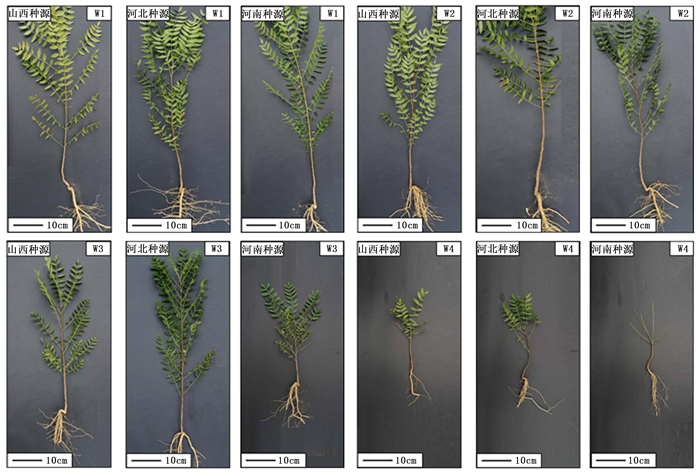

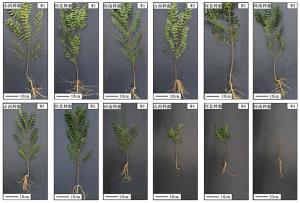
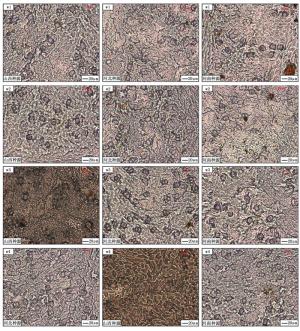
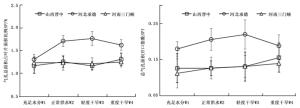
 DownLoad:
DownLoad:
